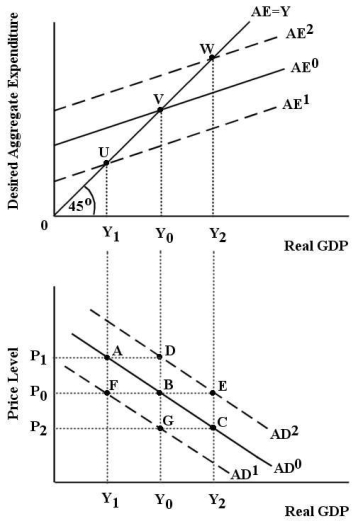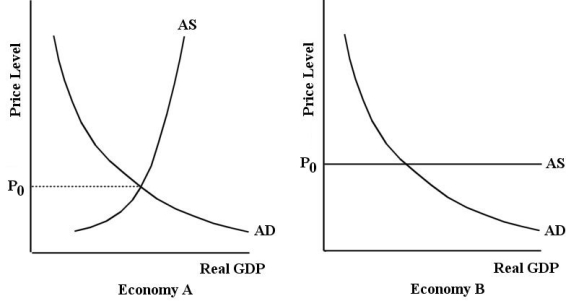A) Canadian goods become more expensive relative to foreign goods.
B) the net export function shifts upward.
C) the aggregate expenditure function shifts downward.
D) imports of foreign goods rise.
E) the net export function shifts downward.
G) C) and E)
Correct Answer

verified
Correct Answer
verified
Multiple Choice
Consider the basic AD/AS model.Suppose that high-school graduates have better computing skills than did graduates in the past,resulting in an increase in average labour productivity.This change will
A) shift the AS curve to the left.
B) shift the AS curve to the right.
C) shift the AD curve to the left.
D) shift the AD curve to the right.
E) cause a movement along the AS curve to the right.
G) B) and C)
Correct Answer

verified
Correct Answer
verified
Multiple Choice
Consider the relationship between the AE curve and the AD curve.A fall in the amount of desired consumption,investment,government purchases,or net exports at any given level of national income
A) shifts the AD curve to the left.
B) shifts the AD curve to the right.
C) causes a movement along the AD curve.
D) causes a movement along the AE curve.
E) causes a shift of the AE curve but no movement of the AD curve.
G) C) and E)
Correct Answer

verified
Correct Answer
verified
Multiple Choice
A leftward shift of the aggregate demand (AD) curve could result from a fall in
A) autonomous government purchases.
B) induced imports.
C) the net tax rate.
D) autonomous desired saving.
E) the price level.
G) A) and B)
Correct Answer

verified
Correct Answer
verified
Multiple Choice
Consider a simple macro model with demand-determined output.Other things being equal,the price level and desired aggregate expenditure are related to each other
A) positively.
B) proportionally.
C) progressively.
D) exponentially.
E) negatively.
G) A) and D)
Correct Answer

verified
Correct Answer
verified
Multiple Choice
Aggregate supply refers to the
A) decisions of firms to decrease inputs in order to produce outputs.
B) effects of increases in input prices on output.
C) economy's potential output at each possible labour force.
D) supply of labour inputs in the economy.
E) total output of goods and services that firms would like to produce and sell.
G) All of the above
Correct Answer

verified
Correct Answer
verified
Multiple Choice
Other things being equal,a closed economy will have a ________ marginal propensity to spend and thus a ________ AD curve compared to an open economy with foreign trade.
A) lower; flatter
B) higher; flatter
C) higher; steeper
D) lower; rightward shift of the
E) lower; leftward shift of the
G) C) and D)
Correct Answer

verified
Correct Answer
verified
Multiple Choice
The AD curve shows the relationship between
A) the price level and the equilibrium level of demand-determined national income.
B) AS and real national income.
C) real national income and AE.
D) AS and AE.
E) the price level and desired consumption.
G) B) and C)
Correct Answer

verified
Correct Answer
verified
Multiple Choice
On a graph that shows the derivation of the AD curve,an exogenous change in the price level causes
A) a shift in the AE curve and a movement along the AD curve.
B) a shift in both the AE and AD curves.
C) a movement along the AE curve and a shift in the AD curve.
D) a movement along the AE curve but not along the AD curve.
E) a movement along both the AE and AD curves.
G) A) and B)
Correct Answer

verified
Correct Answer
verified
Multiple Choice
 FIGURE 23-1
-Refer to Figure 23-1.Assume the economy is initially in equilibrium with desired aggregate expenditure equal to real GDP at point V.The price level is
FIGURE 23-1
-Refer to Figure 23-1.Assume the economy is initially in equilibrium with desired aggregate expenditure equal to real GDP at point V.The price level is  .Now,suppose the AE curve shifts to
.Now,suppose the AE curve shifts to  and we move to a new equilibrium level of GDP at
and we move to a new equilibrium level of GDP at  and point E on
and point E on  .A possible cause of this change in equilibrium is
.A possible cause of this change in equilibrium is
A) an increase in government purchases.
B) an increase in the net tax rate.
C) a decrease in desired investment.
D) a decrease in desired net exports.
E) an exogenous fall in the price level.
G) All of the above
Correct Answer

verified
Correct Answer
verified
Multiple Choice
Consider the following news headline: "Information technology costs for Canadian firms continue to drop." Choose the statement below that best describes the likely macroeconomic effect.
A) the AD curve shifts to the right; the price level rises and real GDP rises
B) the AD curve shifts to the left; the price level falls and real GDP falls
C) the AS curve shifts to the left; the price level rises and real GDP falls
D) the AS curve shifts to the right; the price level falls and real GDP rises
E) the AD and AS curves both shift to the right; the effect on the price level is indeterminate and real GDP rises
G) B) and E)
Correct Answer

verified
Correct Answer
verified
Multiple Choice
 FIGURE 23-1
-Refer to Figure 23-1.Assume the economy is initially in equilibrium with desired aggregate expenditure equal to real GDP at point V.The price level is
FIGURE 23-1
-Refer to Figure 23-1.Assume the economy is initially in equilibrium with desired aggregate expenditure equal to real GDP at point V.The price level is  .Now,suppose the AE curve shifts to
.Now,suppose the AE curve shifts to  and we move to a new equilibrium level of GDP at
and we move to a new equilibrium level of GDP at  and point C on
and point C on  .A possible cause of this change in equilibrium is
.A possible cause of this change in equilibrium is
A) an increase in autonomous consumption.
B) an increase in desired investment.
C) an exogenous fall in the price level.
D) an exogenous rise in the price level.
E) an increase in desired net exports.
G) A) and C)
Correct Answer

verified
Correct Answer
verified
Multiple Choice
Suppose firms are currently producing output at a level beyond their normal capacity.In this situation,the AS curve will be relatively ________ and a positive AD shock will result in ________.
A) steep; an increase in the price level with a small increase in real GDP
B) flat; an equal increase in the price level and in real GDP
C) flat; a very small increase in prices but a large increase in real GDP
D) flat; a very small decrease in the price level and a decrease in real GDP
E) steep; a decrease in the price level and a very small decrease in real GDP
G) A) and D)
Correct Answer

verified
Correct Answer
verified
Multiple Choice
Consider the basic AD/AS model.Suppose firms are currently producing beyond their normal capacity.A change in AD leads to a relatively
A) large change in price level and a large change in real GDP.
B) large change in price level and a small change in real GDP.
C) small change in price level and a large change in real GDP.
D) small change in price level and a small change in real GDP.
E) no change in both price and output.
G) A) and D)
Correct Answer

verified
Correct Answer
verified
Multiple Choice
Consider the economy's aggregate supply curve.Other things being equal,unit costs will tend to fall if
A) there is a fall in the price of oil.
B) the government increases payroll taxes.
C) wages fall.
D) wage and price controls are in effect.
E) wage increases are less than productivity increases.
G) A) and E)
Correct Answer

verified
Correct Answer
verified
Multiple Choice
Suppose there is a drop in the price of an important factor input.What will be the effect on the aggregate supply curve?
A) There will be movement to the left,along the AS curve.
B) The AS curve will shift to the left.
C) There will be movement to the right,along the AS curve.
D) The AS curve will shift to the right.
E) There will be no change in the AS curve.
G) B) and E)
Correct Answer

verified
Correct Answer
verified
Multiple Choice
 FIGURE 23-5
-Refer to Figure 23-5.Suppose that an increase in government purchases caused the AD curve to shift to the right,as shown.If the simple multiplier in this model is 5,then how much was the increase in government purchases?
FIGURE 23-5
-Refer to Figure 23-5.Suppose that an increase in government purchases caused the AD curve to shift to the right,as shown.If the simple multiplier in this model is 5,then how much was the increase in government purchases?
A) 30
B) 40
C) 50
D) 12
E) not enough information to know
G) None of the above
Correct Answer

verified
Correct Answer
verified
Multiple Choice
 FIGURE 23-3
-Refer to Figure 23-3.Which of the following statements correctly describes the difference between the multipliers (in response to an increase in autonomous expenditure) in Economy A and Economy B? The multiplier in Economy A is ________ while the multiplier in Economy B is ________.
FIGURE 23-3
-Refer to Figure 23-3.Which of the following statements correctly describes the difference between the multipliers (in response to an increase in autonomous expenditure) in Economy A and Economy B? The multiplier in Economy A is ________ while the multiplier in Economy B is ________.
A) very small; equal to one
B) very small; equal to the simple multiplier
C) equal to the simple multiplier; almost zero
D) equal to one; almost zero
E) equal to one; equal to the simple multiplier
G) A) and E)
Correct Answer

verified
Correct Answer
verified
Multiple Choice
Consider the relationship between the AE curve and the AD curve.A rise in the amount of desired investment expenditure at each level of national income
A) shifts the AD curve to the left.
B) shifts the AD curve to the right.
C) causes a movement along the AD curve.
D) causes a movement along the AE curve.
E) causes a shift of the AE curve but no movement of the AD curve.
G) C) and E)
Correct Answer

verified
Correct Answer
verified
Multiple Choice
Consider the following two headlines appearing in the same day: "Federal government announces major new infrastructure investments" and "New technology drives down transport costs." Choose the statement below that best describes the likely macroeconomic effects.
A) The AS curve shifts to the left; the price level rises and real GDP falls.
B) The AS curve shifts to the right; the price level falls and real GDP rises.
C) The AD curve shifts to the left; the price level falls and real GDP falls.
D) The AD curve shifts to the right; the price level rises and real GDP rises.
E) The AD and AS curves both shift to the right; the effect on the price level is indeterminate and real GDP rises.
G) C) and E)
Correct Answer

verified
Correct Answer
verified
Showing 121 - 140 of 142
Related Exams